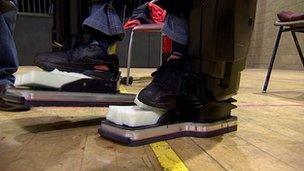Bionic legs developed by Scots engineers go on sale
- Published
New bionic legs, designed by two Scottish school friends, help wheelchair user Elena Bertoldo to walk
Bionic legs designed by two Scottish engineers have been approved for sale in the UK for people who have difficulty walking.
Rex robotic legs were developed by old school-friends from Fort William, Richard Little and Robert Irving.
The pair now live in New Zealand and started work on the project eight years ago after Robert was diagnosed with multiple sclerosis.
Rex Bionics is among a handful of firms who have created exoskeletons.
After diagnose Robert faced a future, like his mother and Richard's mother, using a wheelchair.
"There's a lot of secondary complications with using a wheelchair," Richard Little explained.
"Because you're not using your legs and standing and walking, there's a load of medical complications that come with that.
"So we thought we'd do something different. We would get people back on their feet again."
Futuristic machines
A total of 29 on-board computers and 100 sensors make the bionic legs extremely stable.
The user controls the direction and size of step with a simple joystick. They can go up steps and ramps but are most suitable for man-made smooth floor surfaces.
Elena Bertoldo, who was diagnosed with a spinal problem at birth, has travelled from Italy to the two Scottish engineers' home town of Fort William to try them out.
"It really feels great," she said.
"It's hard to explain - you have to try it. It's like having somebody support you when you need support. I really love it!"
The bionic legs built by the pair are one of a handful of exoskeletons in development around the world.
Other versions have their origins in futuristic machines being developed by the military to give soldiers superhuman strength.
For wheelchair users, exoskeletons offer intriguing possibilities.
"We have engineers who use wheelchairs themselves and they'll jump in Rex and wear it for eight hours a day," said Richard.
"For somebody with a higher level spinal cord injury - and most of the people who use Rex have a spinal cord injury - they'll use it for less time just to get some exercise and to get some benefit from standing."

The bionic legs may be used in UK spinal injury units to help people in their rehabilitation
Although Rex has now been approved for sale in Europe the biggest obstacle remains the price.
Current models cost £95,000, although Rex are keen to point out they expect this to fall to £75,000 by next summer, but it is the possibilities of this technology which are most exciting.
Developers predict exoskeletons will eventually cost the same as advanced electric wheelchairs and they offer a fascinating insight into the walking aids which might one day be possible.
"This was just something that we thought we would build," said Richard.
"When we started on the journey eight years ago the technology wasn't really available.
"We've had to make all the 8,000 parts ourselves. It is still relatively expensive but it is something that will come down in price in time, like all technology."
Even those without tens of thousands of pounds of cash to spare may benefit from the technology.
Rex Bionics are currently in discussions with spinal injury units in the UK about using bionic legs to help people in their rehabilitation.
- Published15 August 2011
- Published15 July 2010